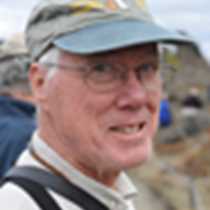Baranof & Chichagof Islands, Southeast Alaska
Yesterday evening we departed Sitka, on the outer coast of Baranof Island, and our adventure in Southeast Alaska was underway. During the night the National Geographic Sea Bird made her way through Olga, Neva, and then Peril Straits, which separates the two large islands of Baranof and Chichagof. We poked into Sitkoh Bay on Chichagof Island, in a Southeast Alaska mist, and spotted a brown bear grazing in a meadow far in the distance. Our morning destination was the Lake Eva trail, across Peril Straits on Baranof Island, for our first walk through the Temperate Rainforest.
The most frequently heard question on the National Geographic Sea Bird is “Do we need the boots?” Some are reluctant to believe the simple answer “Yes; you need the boots.” Today, we needed the boots.
The Lake Eva Trail, constructed by the U.S. Forest Service, is famous for the beauty of the Old Growth Forest that surrounds the stream flowing from Lake Eva, and for the boot-sucking mud and roots that comprise the trail. Giant trees of Sitka spruce and western hemlock adorn the slopes, and a rich carpet of moss, ferns, and small herbs covers the forest floor. The meadows are rich in flowering plants just now at the peak of color: the yellow of buttercups and silverweed, red of paintbrush, magenta of shooting star, and the rich purple-brown of the chocolate lily. The bush blueberries have finished their flowering. The berries are just beginning to form, promising future delicacies for bears and hikers alike. And as we hiked we found ample evidence that we share this trail with Alaska’s brown bears.
Across Peril Straits, we entered Sitkoh Bay for our afternoon activities. There we chose different modes of transport. Some climbed into one of our fleet of colorful kayaks for a one-way trip up the Bay. Others opted for a pulse-raising walk along an old logging road, and some simply meandered through the forest.
Evidence of historic Alaska was all around us. The forest here has some of the largest spruce and hemlock trees that we will see, centuries old and reaching four to six feet in diameter. The trees that stand today germinated in the forest long before the Russians dreamed of the riches of this great land. In the earliest part of the 20th Century, after Alaska had passed from Russian to American dominion, huge trees were felled by two men with a buck-saw and hauled from the forest using teams of horses. Their stumps still stand as ghosts in the forest, their history indicated by “spring board notches” where the sawyers stood. This form of local and selective logging stands in stark contrast to the modern practice of clear-cut forestry, in which every stem over acres of forest is cut and the logs are transported to tideline by trucks over logging roads carved into the landscape. Much of the forest of this part of Southeast Alaska has been cut; we spent our day surrounded by plots in stages of their slow recovery.
As a final treat, our Captain spotted an Alaskan Coastal brown bear foraging in the grass just above the tideline, and he maneuvered the National Geographic Sea Bird to give us excellent views of this iconic symbol of the Alaskan wilderness.




